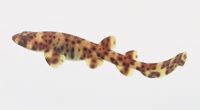Shark Cannibalism and Early Life
Ovoviviparous shark pups depend on yolk for nutrition, and when an embryo has expended its own yolk sac, it turns to the eggs around it. Some species practice intrauterine cannibalism, or eating the other fertilized or unfertilized eggs in the womb.
The best-known intrauterine cannibal is the sand tiger shark. Although the sand tiger shark has two uteri and produces many eggs, each litter yields just two pups -- one from each uterus. That's because as the sharks develop their embryonic teeth, they start to eat the other embryos, killing their unborn brothers and sisters, as well as the unfertilized eggs. It's survival of the fittest in the womb, until only one shark remains. Because of their pre-birth diet, sand tiger pups enter the world bigger than other pups; they measure approximately three feet (one meter) long [source: National Aquarium].
Advertisement
The sand tiger's cannibalism is known as adelphophagy, which literally means "eating one's brother" [source: Martin]. But other sharks practice cannibalism as well, albeit in a slightly more subdued form known as oophagy, which is the eating of eggs that haven't been fertilized. Approximately 14 species of sharks are thought to practice some form of intrauterine cannibalism [source: Martin].

Frank Greenaway/Dorling Kindersley/Getty Images
The swell shark as an embryo...and as a two-month-old pup.
The number of shark pups in a litter varies among species; the sand tiger shark gives birth to one or two, while the viviparous blue shark has been known to give birth to 134 pups in one litter [source: Cooper]. The whale shark has given birth to 300, but such high numbers are rare [sources: Conrath, Greven]. But whether hatched from an egg or born live, shark pups emerge as miniature versions of the sharks they will become.
Shark pups are also very independent, and those that are born live swim away from their mothers as soon as they're born, perhaps to avoid being eaten. Even the tiniest sharks face the world on their own. Shark pups don't receive any further nourishment or support from their parents. It's up to the pup to find food and evade predators.
A shark pup's success in life is largely determined by its size at birth and whether the female shark has used a nursery area, or a shallow part of the sea with fewer predators than the open sea. Some shark species grow very slowly, putting them in danger of being eaten by bigger sharks for longer. If few pups survive to maturity and reproduce themselves, shark species could be in danger, particularly those subject to other pressures, such as fishing.
For these reasons, scientists keep trying to learn more about how shark pups are born. Knowing which species have infrequent mating periods, long gestation periods, low litter counts or slow growth will aid efforts in conservation and protection.
Scientists are currently working to develop an artificial shark womb. In the case of the sand tiger shark, a low birth rate in combination with overfishing is causing the sand tiger shark to disappear. When scientists determine exactly how to mimic the womb environment, the plan is to catch pregnant sand tiger sharks, remove embryos and insert them into the test tube wombs for the gestation period. Then, the shark pups would be released back into the wild [source: Bartlett].
